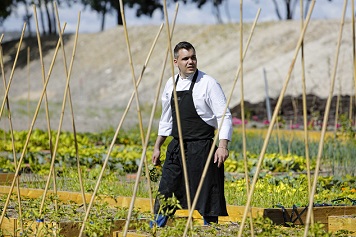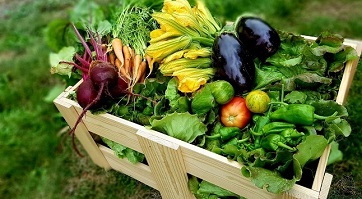
SARDÓN DE DUERO, SPAIN—Abadía Retuerta LeDomaine is channeling its historic roots—and providing guests with the ultimate locally sourced, organic and flavorful produce in the property’s restaurants—with the creation of a large vegetable garden adopting the sustainable techniques and methods used by the abbey’s original monk inhabitants in the 12th century.
The location between the abbey and the river is not only ideal because of the fertile soil and abundance of water, but is the very spot where the monks had their vegetable garden almost 900 years ago. More than 90 vegetable varieties, including 10 different types of tomato, are currently being grown. This is a test year, studying how crops behave and coexist, that will determine what is planted going forward.
“We have resurrected the monastic model of working the land at Abadía Retuerta LeDomaine with an organic, sustainable and biodynamic vegetable garden that is in tune with the natural environment of the estate,” said CEO Enrique Valero. “We already have an abundant harvest of lettuces, eggplant, peppers, tomatoes, beets and much more that our chefs are turning into delicious dishes for our guests.”
‘Deep and Mouthwatering Flavor’
“The vegetables we grow at LeDomaine, in the ultra-fertile soil by the river, are of the highest quality with rich, deep and mouthwatering flavor,” said Chef Marc Segarra. “Having our own exceptional produce has added a new dimension of taste to our menus, as well as allowed us to be extra creative. It’s currently zucchini season, for example, and we are preparing a unique version of Pasta Carbonara with roasted zucchini that is a huge hit with our guests.”
In following the biodynamic monastic model, which seeks to live in harmony with the rhythms of the universe, the vegetables are sowed in conjunction with seasonal patterns, traditional crop calendar principles are applied, and farming tasks are carried out following the phases of the moon and the location of the stars. An efficient drip irrigation system, perfected over time at Abadía Retuerta’s vineyards, saves water in the vegetable garden: One to three hours and just two days a week are enough to water the vegetable garden.
 The garden is organized into six different areas, each with one or more rows. The first is dedicated to aromatic and medicinal plants, which were used centuries ago by the monks. They are grown in barrels from the winery cut in half—adding a special charm to the vegetable plot. The second row is for the flowers that are used as centerpieces and bouquets in the hotel and, in a critical function, help to preserve the natural balance of the garden: flowers attract insects that pollinate crops and feed on the bad insects which cause diseases.
The garden is organized into six different areas, each with one or more rows. The first is dedicated to aromatic and medicinal plants, which were used centuries ago by the monks. They are grown in barrels from the winery cut in half—adding a special charm to the vegetable plot. The second row is for the flowers that are used as centerpieces and bouquets in the hotel and, in a critical function, help to preserve the natural balance of the garden: flowers attract insects that pollinate crops and feed on the bad insects which cause diseases.
Several sections—with five rows—are devoted to vegetables grown in very large raised beds with organic sheep manure. Next are four rows of soil covered with compost, where crops are planted in much greater density and rotated. Lastly, a mixed area combines flowers, fruit trees and crops that need more space such as pumpkins, melons and watermelons. The flavorful produce enhances the menus of all the hotel’s restaurants including the Vinoteca small-plates wine bar, the Cloisters spring and summer courtyard restaurant, and the One-Michelin-Star Refectorio restaurant.





